|
Galaxy Morphology and Comparison of 4 Galaxies - by Ricky Leon Murphy:
Normal Spiral Galaxies
Bared Spiral Galaxies
M51
M63
NGC4258
NGC4725
Summary
Comparison Chart
References
Web Sites
Image Credits
Back to
Astrophotography
Stars
are grouped into “island universes” called galaxies and there are three
types of galaxies in our Universe: elliptical, spiral, and irregular.
Elliptical galaxies are usually small
and contain older stars, little dust and gas, and do not have any
organized rotation. Irregular galaxies have no discernable structure or
spiral arms, but they are usually small and do contain dust and gas with
associated hot stars. Spiral galaxies have a bulge of older stars with
prominent spiral arms with dust, gas and new star formation. They also
have an organized rotation. This project will focus on the comparison of
four spiral galaxies using provided images from the McDonald Observatory
at Fort Davis, Texas. Using standard image reduction techniques, the
data from this observatory is reduced and merged to a full color
composite image. We will examine in detail the properties of a spiral
galaxy. In addition, we will be using the Hubble Tuning Fork Diagram as
well as reference material to provide a detailed analysis of each
galaxy.
Edwin
Hubble is responsible for creating the classification of galaxies using
a tool called the “Tuning Fork Diagram:”
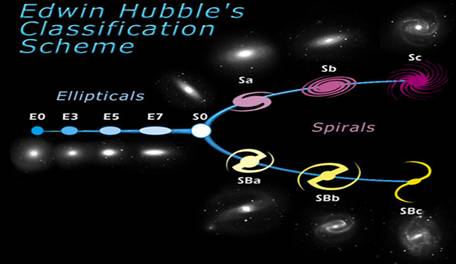
Figure 1: (Image
Credit)
This diagram demonstrates
the major groups (irregular galaxies are not shown on this particular
diagram) and their varieties. While this chart was initially thought to
be an evolutionary map of galaxies, it is now known that galaxies in one
particular group will not evolve into another.
This project will focus on the right side of the diagram – spiral
galaxies. There are two sub-categories of spiral galaxies:
-
“Normal” spiral
galaxies – galaxies that have their spiral arms attached to the
bulge
-
Bared spiral
galaxies – galaxies that have their spiral arms attached to a bar
that protrudes from the bulge.
The image below shows a
diagram I made of our own Milky Way galaxy – which is a spiral galaxy:
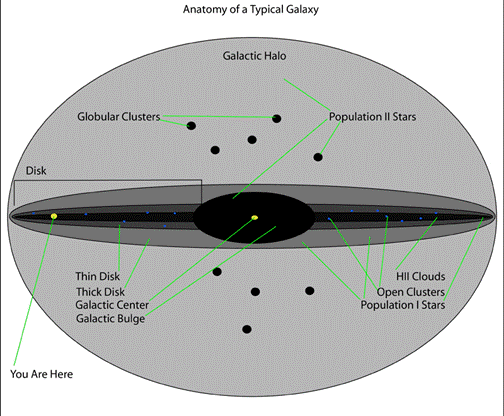
The bulge of a spiral
galaxy contains older stars while the spiral arms contain dust and
newer, hotter stars and their associated hydrogen dust clouds (Universe,
page 582).
In order to classify
spiral galaxies, it is necessary to look at two variables: the
brightness of the bulge and the organization of the spiral arms.
Back to Top
| Back to
Astrophotography
For
normal spiral
galaxies:
(http://cas.sdss.org/dr3/en/astro/galaxies/galaxies.asp)
(Sparke and Gallagher, page 34 – 35)
|
Classification: |
Description: |
|
Sa |
Bright core,
tightly wound spiral arms |
|
Sb |
Core dimmer
than Sa, spiral arms more loose |
|
Sc |
Core dimmer
than Sb, open spiral structure, more dust and gas |
|
Sd |
Dim core,
loosely wrapped spiral structure, lots of dust and gas and new
star growth |
Examples
(Figure 2):

Back to Top
| Back to
Astrophotography
For bared spiral galaxies:
(http://cas.sdss.org/dr3/en/astro/galaxies/galaxies.asp)
(Sparke and Gallagher, page 34 – 35)
|
Classification: |
Description: |
|
SBa |
Bright core,
tightly wound spiral arms |
|
SBb |
Core dimmer
than Sa, spiral arms more loose |
|
SBc |
Core dimmer
than Sb, open spiral structure, more dust and gas |
|
SBd |
Dim core,
loosely wrapped spiral structure, lots of dust and gas and new
star growth |
Examples
(Figure 3):

Sa and SBa galaxies are almost always brighter that Sd an SBd galaxies.
The organization of spiral galaxies and bared spiral galaxies are the
same.
Some other important
properties of spiral galaxies include (Sparke and Gallagher, page 172 –
214):
-
Spiral galaxies
produce most of the luminous light in the Universe due to new star
birth in the spiral arms
-
Majority of galaxies
in the Universe are spiral galaxies
-
Half of all spiral
galaxies are in the bared spiral class
-
Spiral galaxies obey
the Tully-Fisher relation – brighter galaxies rotate faster
-
Spiral galaxy
rotation curves are dominated by Dark Matter
-
Rotation of stars in
the spiral arms are organized while the rotation of stars in the
bulge are not (random rotation orbits about the nucleus)
While the properties of
spiral galaxies are classed by the apparent visual brightness of the
core, some spiral galaxies do contain active galactic nuclei, or AGN.
The Seyfert galaxy is a galaxy with such an active nucleus (probably
powered by a large black hole) and results in a brighter than usual
bulge. The Unified AGN Model is a theory that describes the class of
galaxies that result from a black hole at the center of a galaxy as well
as the orientation of the galaxy toward its observer (us). Quasars,
radio galaxies, and Seyfert galaxies all fall within the category of AGN,
but is not covered by the scope of this project.
A
Seyfert or other AGN galaxy does affect the classification system. If
the bulge is brighter but the spiral arms more loose, it is required to
combine classes. Galaxy NGC4258, covered below, is an example of such a
galaxy. For example, a spiral galaxy “S” can have a bright core
(sub-class “a” or “b”) but can have a loose spiral structure (sub-class
“c” or “d”). The result will be something like Sac or Sbd.
Back to Top
| Back to
Astrophotography
Galaxy M51:
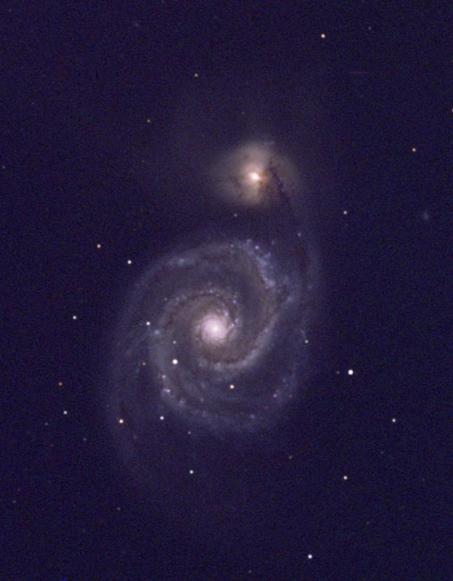
In the constellation
Canes Venatici, shining at a visible magnitude of 8.4 is the Whirlpool
Galaxy, or M51. This galaxy also carries the designation NGC5194. Once
thought to be a giant swirling nebula, this object was determined to
have a spiral structure in 1845 by Lord Rosse’s 72 inch “Leviathan”
telescope (O’Meara, page 160). This galaxy is about 35 million light
years away and shines with a luminosity of about 10 billion Suns.
Additionally, this galaxy has a mass of 160 billion Suns and is
comparable in size to the Andromeda Galaxy – 100,000 light years in
diameter (M31) (Burnham, page 369 – 371). M51 is a face on spiral
galaxy, which allows us a detailed look at the spiral structure. Since
the spiral arms are loose and bulge relatively dim, this galaxy is
classed as a Sc type spiral galaxy (Burnham, page 369). In addition,
this galaxy has an interacting companion, NGC5195 (http://www.starfred.com/ngc5194a.htm).
Redshift measurements of this companion galaxy show it to be the same
distance as M51, so this is truly an interacting galaxy (Burnham, page
371).
The image of M51 shows
the spiral structure well. It is possible to see some brighter regions
of new star growth throughout the spiral structure as well as the
overall blue color indicating the presence of larger, hotter new stars
as well as associated dust lanes. It is also possible to see the gold
color of the bulge indicating the presence of older stars. In addition,
it is also possible to visualize the disruption of the smaller companion
galaxy as there is no clearly defined spiral structure.
Back to Top
| Back to
Astrophotography
M63:
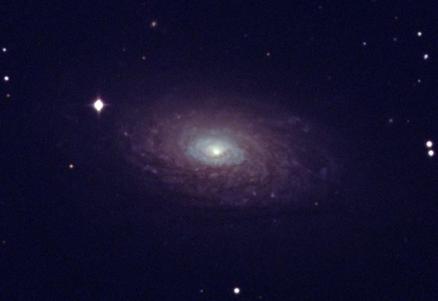
Also in the constellation
of Canes Venatici is the 8.6 magnitude spiral galaxy M63. This galaxy
also carries the designation NGC5055. Called the Sunflower galaxy, it
appears as though this galaxy has lost any discernable spiral structure
(O’Meara, page 188), but instead is a tight wound spiral galaxy
designated with the class Sb (Burnham, page 373). This galaxy is similar
to M51 in that its distance is also 35 million light years away and its
luminosity is also that of 10 billion Suns. It is not as large as M51,
with a diameter of 90,000 light years and has a mass of 115 billion
Suns.
The core of this galaxy
is very bright and does seem to overpower the brightness of the spiral
arms giving the appearance of a flocculent design. This galaxy is
inclined to us by 30 degrees which allows for the almost “sunflower”
appearance (Burnham, page 373). While the dust lanes are not as
prominent as M51, it is still possible to see the bluer color of the
spiral arms versus the gold color of the bulge.
Back to Top
| Back to
Astrophotography
NGC4258:
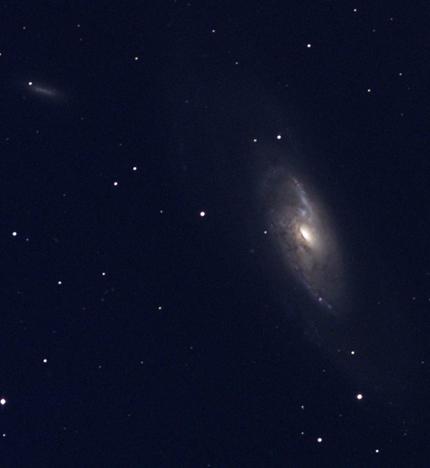
NGC4258 is in also in the
Canes Venatici constellation. Also known as M106, this 8.4 magnitude
galaxy is special in that it is also a Seyfert II type galaxy – that is,
there is a black hole at the heart of this galaxy that results in bright
radio emissions (O’Meara, page 274). The luminosity of this galaxy is
much less than M51 or M63 shining at only 1.3 billion Suns. This is
probably the result of this being a smaller galaxy in that it has a mass
of 40 billion Suns (http://hubblesite.org/newscenter/newsdesk/archive/releases/1997/01/text/).
The loose nature of the spiral arms suggests a Sc class, but the bright
Seyfert nucleus is more in line with a Sb class galaxy. As such, it has
been combined to be a class Sbc galaxy (Sparke and Gallagher, page 306).
The force driving the
Seyfert core is suggested to be the gravity interaction of a companion
galaxy, designated NGC 4217 (Mouri and Taniguchi, 2004):
The companion galaxy is
seen in the upper left of NGC 4258. It is possible that the loose
structure of NGC4258 is also the result of the companion galaxy.
Back to Top
| Back to
Astrophotography
NGC4725:
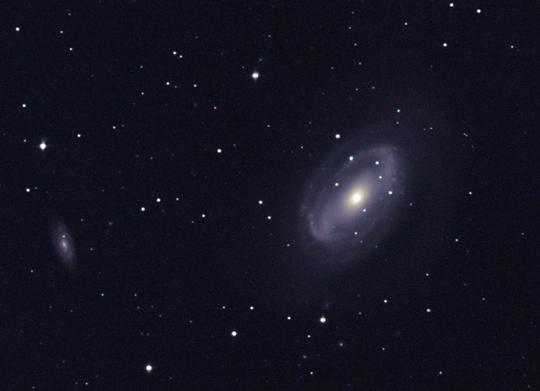
The only bared spiral
galaxy in our group of four is NGC4725. Shining at a dim magnitude of
9.2, this bared spiral is also a Seyfert galaxy as indicated by its
bright nucleus. This galaxy is a distant 40 million light years and is a
class SBa type galaxy – evident by the tightly wound spiral structure.
What is fascinating about this galaxy is the determination of the
distance to this galaxy was made possible by the use of 20 Cepheid
variable stars (Gibson et al., 1999).
The diameter of this galaxy is also less than M51 or M63 at “only”
54,000 light years (Laine et al., 2002).
As mentioned, NGC4725 is
a Seyfert galaxy – a Type II just like NGC4258. And just like NGC4258,
the resulting energy of the Seyfert engine is also believed to be a
result of a companion galaxy (Mouri and Taniguchi, 2004). The companion
galaxy, NGC4747, is seen to the left of NGC4725. The size of the
companion, as compared to the companion NGC4258, seems more likely to
cause the gravity interactions driving the Seyfert core of NGC4725.
Back to Top
| Back to
Astrophotography
Summary:
Spiral
galaxies come in a variety of flavors. Our sample included a broad
spectrum of galaxies. M51, the only interacting galaxy of our group has
a clearly defined spiral structure that is face on. The tight spiral
structure of M63 demonstrates a bright center. A loose spiral Seyfert
galaxy is also included in our roundup and demonstrates that a mixing of
classes is also possible. Our final galaxy is a bared spiral and also a
Seyfert galaxy. This variety allows for a broad sample of study for
Astronomers. For the photographer, this offers a wide choice of subjects
for display at the home or office.
Back to Top
| Back to
Astrophotography
Comparison Chart:
|
Galaxy
Name: |
M51 |
M63 |
NGC4258 |
NGC4725 |
|
Constellation: |
Canes Venatici |
Canes Venatici |
Canes Venatici |
Coma Berenices |
|
Distance: |
35 million l.y. |
35 million l.y. |
22 million l.y. |
40 million l.y. |
|
Type: |
Sc |
Sb |
Sbc |
SBa |
|
Luminosity: |
10 billion Suns |
10 billion Suns |
1.3 billion Suns |
--- |
|
Diameter
(in light years): |
100,000 l.y. |
90,000 l.y. |
--- |
54,000 l.y. |
|
Mass: |
160 billion Suns |
115 billion Suns |
40 billion Suns |
--- |
|
Apparent
Magnitude: |
8.4 |
8.6 |
8.4 |
9.2 |
|
Apparent
Diameter: |
11 arcmin |
12 arcmin |
18 arcmin |
11.0 arcmin |
Data gathered from
Burnham’s, The NGC/IC Project, NED and Hubble.
Back to Top
| Back to
Astrophotography
References:
Burnham, Robert.
Burnham’s Celestial Handbook. Volume One. Dover Publications, New
York. 1978.
Burnham, Robert.
Burnham’s Celestial Handbook. Volume Two. Dover Publications, New
York. 1978.
Freedman, Rodger and
William Kaufman. Universe. Seventh Edition. W.H. Freeman and
Company, New York. 2005.
Gibson, Brad et al. “The
Hubble Space Telescope Key Project on the Extragalactic Distance Scale.
XVII. The Cepheid Distance to NGC 4725.” The Astrophysical Journal,
512:48-64, 1999 February 10.
Laine, Seppo et al.
“Nested and Single Bars in Seyfert and Non-Seyfert Galaxies.” The
Astrophysical Journal, 567:97-117, 2002 March 1.
Mouri, Hideaki and
Yoshiaki Tanighuchi. “Galaxy Interaction and the Starburst-Seyfert
Connection.” The Astrophysical Journal, 605:144-155, 2004 April 10.
O’Meara, James. The
Messier Objects. Cambridge University Press, 2000.
Sparke, Linda and John
Gallagher. Galaxies in the Universe. An Introduction. Cambridge
University Press, 2000.
Back to Top
| Back to
Astrophotography
Websites:
Sloan Digital Sky Survey:
http://cas.sdss.org/dr3/en/astro/galaxies/galaxies.asp
Galaxy Classification:
http://www.astr.ua.edu/keel/galaxies/classify.html
The NGC/IC Project:
http://www.ngcic.org/
NED – NASA/IPAC
Extragalactic Database:
http://nedwww.ipac.caltech.edu/
M51:
http://www.starfred.com/ngc5194a.htm
M63:
http://www.starfred.com/ngc5055.htm
NGC4258:
http://hubblesite.org/newscenter/newsdesk/archive/releases/1997/01/text/
NGC4258:
http://www.starfred.com/ngc4258.htm
NGC4725:
http://www.starfred.com/ngc4725.htm
Back to Top
| Back to
Astrophotography
Image Credits:
Figure 1:
http://staff.imsa.edu/science/astro/astrometry/images/TuningFork.jpg
Figure 2 and 3:
http://cas.sdss.org/dr3/en/astro/galaxies/galaxies.asp
Galaxy image provided by
the McDonald Observatory and reduced by the author
Back to Top |
Back to
Astrophotography |

